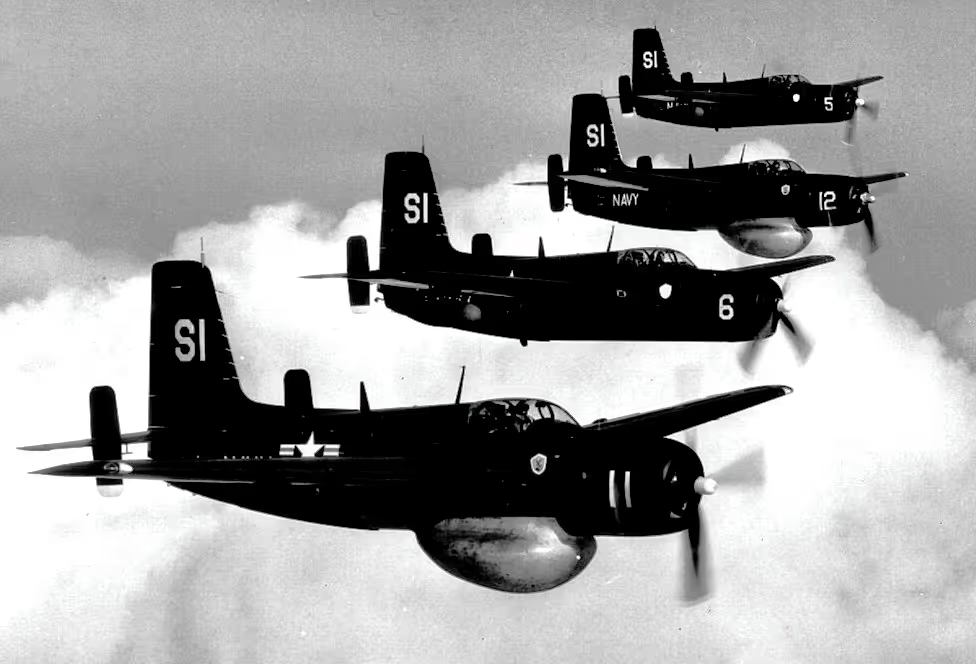Warplanes of the USA: Grumman AF Guardian
Grumman AF Guardian

(USN Photo)
The second U.S. Navy Grumman AF-2W Guardian (BuNo 123091), in flight probably near Bethpage, New York (USA), circa 1950.
The Grumman AF Guardian is the first purpose-built anti-submarine warfare (ASW) carrier-based aircraft to enter service with the United States Navy. It consisted of two airframe variants, one for detection gear, the other for weapons. The Guardian remained in service until August 1955, when it was replaced by the twin-engined Grumman S-2 Tracker. The Guardian was the largest single-engine piston-powered carrier aircraft ever to see service. (Wikipdeia)

(USN Photo)
A Grumman AF-2W Guardian (BuNo 130389) from anti-submarine squadron VS-37 in flight circa July 1957.

(USN Photo)
A Grumman AF-2S Guardian of the Museum of Naval Aviation painted in the colours of antisubmarine aquadron VS-25 pictured in flight. Officil NMNA description: "Accepted by the U.S. Navy 6 July 1950, the museum's AF-2S entered squadron service with Experimental and Development Squadron (VX) 1 at Naval Air Station (NAS) Key West, Florida, where it served as a flight test aircraft until February 1952. Between 1952 and 1956, it flew with various Naval Air Reserve Units at NAS Jacksonville, Florida, NAS Willow Grove, Pennsylvania, and NAS South Weymouth, Massachusetts. Stricken from the Navy inventory at the naval storage facility at Litchfield Park, Arizona, on 17 December 1956, the aircraft was eventually sold in 1958 to Clayton Curtis of Frontier Airways. At the time of sale, it had accumulated 1469 hours of flight time. Subsequently acquired by Aero Union Corporation of Reading, California, in 1962, the aircraft served as an aerial tanker fighting forest fires until 1978, at which time it began flying on the exhibition circuit. Fully restored, it was acquired by the museum in 1980. As the seventh AF-2S version of the Guardian built by Grumman, the aircraft was one of the earliest in service and, at the time of its acquisition, it was the only flying example of its kind. Painted in the markings of Antisubmarine Squadron (VS) 25, one of the first squadrons to operate the AF, the aircraft resides in the west wing of the museum. The "30" painted on the cowling is not historically accurate but instead stems from the aircraft's days as a fire fighter. At that it had the radio call sign "Red 30.""
After disposal by the U.S. Navy fiveGuardians saw many years service with Aero Union based at Chico, California, inthe forest firefighting role, the last being retired in 1978.

(USN Photo)
A U.S. Navy Grumman XTB3F-1S Guardian (BuNo 90506) at the Naval Air Test Center Patuxent River, Maryland (USA), on 21 December 1949. This version of the Grumman Guardian was later redesignated AF-2W.

(USN Photo)
Close-up view of the radome on a U.S. Navy Grumman AF-2W Guardian of Antisubmarine Squadron VS-22 with its engine running at Naval Air Station Norfolk, Virginia.

(USN Photo)
An armed U.S. Navy Grumman AF-2S Guardian, ca. 1951.

(USN Photo)
Grumman AF-2S and AF-2W (with radome) Guardian of Anti-submarine Squadron VS-24 fly in formation over Norfolk, Virginia (USA), circa January 1951.

(USN Photo)
A U.S. Navy Grumman AF-2S Guardian from Anti-Submarine Squadron 37 (VS-37) "Rooster Tails" landing on board the escort carrier USS Badoeng Strait (CVE-116) on 1 April 1954. This was the ship's 20,000th landing.
%2C_in_1953.avif)
(USN Photo)
A U.S. Navy Grumman AF-2S Guardian of Anti-Submarine Squadron 30 (VS-30) "Sea Tigers" about to launch from the escort carrier USS Block Island (CVE-106). VS-30 was assigned to the Block Island for cruises to the Caribbean Sea, the Mediterranean Sea and the North Atlantic an Europe between 5 January and 26 June 1953.
_in_1952.avif)
(USN Photo)
The U.S. Navy escort carrier USS Sicily (CVE-118) underway, with Grumman AF-2S and AF-2W Guardians of Anti-Submarine Squadron VS-931, circa in October 1952, en route to Hawaii.
_in_1951_(NNAM.1996.253.6135).avif)
(USN Photo)
A U.S. Navy Grumman AF-2W Guardian of Anti-Submarine Squadron 931 (VS-931) on the deck of the light aircraft carrier USS Bataan (CVL-29), circa 1951. The squadron had been established as U.S. Naval Reserve composite squadron VC-931 in 1948. It was activated as VS-931 on 1 March 1951 and redesignated VS-20 on 4 February 1953. It was already disestablished again in 1957.
%2C_in_1953.avif)
(USN Photo)
A U.S. Navy Grumman AF-2W Guardian of Anti-Submarine Squadron 24 (VS-24) after a crash landing aboard the escort carrier USS Point Cruz (CVE-119), in 1953.
.avif)
(Bill Larkins Photo)
After retiring N3144G as an air tanker they restored it to original Navy colors as a warbird. Photo at Livermore, California, on 10 March 1974 just after it was painted.
_departing_San_Diego%2C_California_(USA)%2C_in_January_1954_(NH_97444).avif)
(USN Photo)
The U.S. Navy escort carrier USS Rendova (CVE-114) departing San Diego, California (USA), in January 1954. The aircraft on deck are twelve Grumman AF Guardian, forward, and six Grumman TBM Avenger of Anti-Submarine Squadron 20 (VS-20). The submarine tender USS Sperry (AS-13), with submarines alongside, and another tender are moored in the background.
Grumman AF Guardians on display
AF-2S
.avif)

(Greg Goebel Photos)
_(8813125027).avif)
(Tomas Del Coro Photo)
123100 – National Naval Aviation Museum at NAS Pensacola in Pensacola, Florida.It was the seventh AF-2S produced. The aircraft was operated as a firefighteruntil 1978. It was acquired by the museum in 1980. It is displayed in thecolors of its first Navy assignment, though still carries the number"30" on the cowling, which for many years was the aircraft'scall-sign as a firefighting aircraft.
.avif)
(aeroprints.com Photo)
.avif)
(Eric Salard Photo)
129233 – Pima Air and Space Museum, Tucson, Arizona. This aircraft is displayed as it appeared while serving as an aerial firefighter with Aero Union in California. During this period the distinctive empennage with twin vertical stabilizers on each horizontal tail were removed to make a more conventional appearance.

(Author Photo)
126731 – Static display at the Arizona Commemorative Air Force Museum in Mesa,Arizona, as a memorial to VAdm James B. Stockdale, who flew this aircraft earlyin his Navy career. Reg. No. N9993Z.

(Bsudicky Photo)
123088 - Chico Air Museum, Chico, California. This aircraft was owned by AeroUnion in California until its purchase by a private owner some time in themid-1970s. After suffering major damage in a crash on 20 September 1981, it was grounded until being donated to the museum on 14 September 2010. It is currently undergoing restoration.
Grumman AF Guardian





